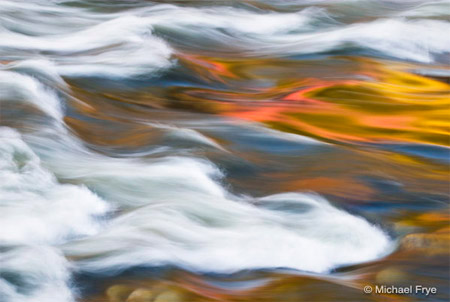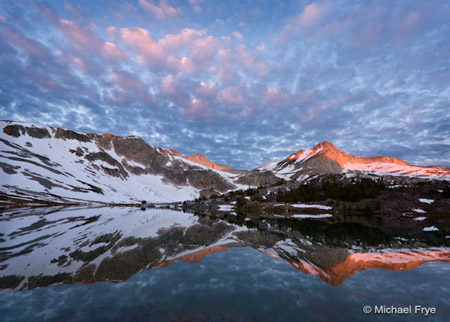Picture: Redbud reflection along the Merced River, California. Photo Courtesy and © Michael Frye

Over the recent New Year’s holiday, I had a chance to read the new e-book, Light & Land; Landscapes in the Digital Darkroom, by veteran landscape and Yosemite photographer, Michael Frye. Published as part of the Craft and Vision titles by editor and publisher David duChemin, this e-book gives a fantastic look inside the post-capture imaging and workflow process. Michael shares his thoughts and technical decision-making about how and why he does what he does to reach the goal of the finished photograph.
I’ve had the chance to meet and talk with Michael on several occasions, but I’ve known about his work for many years, including owning his definitive photographic guidebook to Yosemite Park, The Photographers Guide to Yosemite. (see link below)
One of the questions I get asked most often is, “How do you get your photos to look like that?” This e-book is Michael’s answer to that question, and he delivers that answer with great clarity. With Light & Land, we get to sit alongside Michael as he processes five distinctly different images, each with their own particular set of challenges and decisions. I definitely enjoyed getting a glimpse into the mental and technical steps used by another professional landscape photographer.
One of the nice things Michael shares with his audience is the completely open-handed workflow process, starting with the RAW image. With each subsequent step he shares a screen capture of both the image as well as the Lightroom adjustment control panel that he is using for each step. Finally after going through all of the processing, Michael shares with us a side-by-side view of the RAW file and the final image, affording us a better understanding of the total transformation that occurs between start and finish.
Sunrise, Greenstone Lake, Sierra Nevada Photo Courtesy and © Michael Frye

For the very affordable price of five dollars, Michael delivers great value and great insights into how he works with his RAW image files. The e-book is especially well laid out, and I appreciate the effort that went into documenting and generating screen captures for each step. While there is nothing earth-shattering, new, or secretive in Michael’s processing, more advanced users familiar with RAW imaging will still find this a valuable resource, just as any good chef can learn by watching and appreciating how another fine chef approaches cooking a gourmet meal. For those photographers who are just starting to work with all RAW images, or have feared to tread down that path, I would definitely recommend this e-book as a solid source of information and inspiration, as well as being a guiding hand in working on your own images.
Speaking as one landscape photographer to another, “This is how it’s done.”
See more of Michael’s photography at MichaelFrye.com.
—

This was an interesting and thorough review, thank you Gary. I’ve decided to buy the ebook!